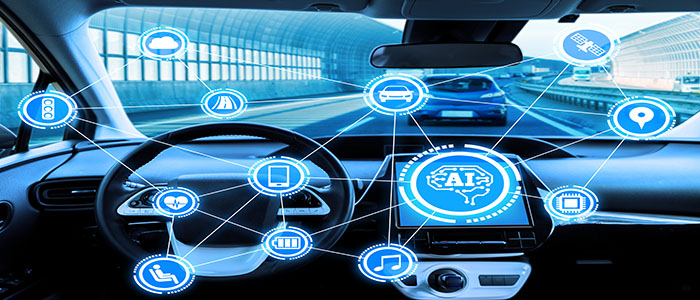If you’d rather get work done, check social media, or send texts than keep your eyes on the road, self-driving vehicles might be just what you’ve been waiting for. And if you can’t drive well because of a disability, autonomous vehicles could be life-changing.
Within the next two years or so, the sight of cars driving themselves around town will not seem surprising. In fact, self-driving cars are already here. Boxy little vehicles from Optimus Ride can be spotted in the p.m. hours (noon to 8) around Tingey Plaza, Garfield Park, Eastern Market Metro, Barracks Row and Capitol Hill. They’re running in collaboration with The Yards near Navy Yard Metro, where their routes begin.
Fledgling to Full Self-Driving
Real, human drivers are inside the Optimus cars in the District. The cars are in safety mode, because they’re still in training. During this early phase, the cars collect data about where they are, and what they find along their routes. In the future, they will have plenty of artificial intelligence (AI) to tap on the move. With their gathered information, their computer systems direct them to their destinations. They will then become fully self-driving cars.
So, are you itching to hail an Optimus Ride? Although the cars are only taking a select few passengers for rides at this time, Optimus will eventually let the public download its Opti Ride app and hail the cars, according to a recent column in the Washingtonian.
But Are They Safe?
The U.S. Department of Transportation has declared the that self-driving, electric cars will become a sustainable form of transit that vastly improves access to mobility and passenger safety. Self-driving cars will also be better than human drivers at spotting kids, animals, or inanimate objects about to come onto the road. Outfitted with Velodyne LiDAR sensors, the Optimus cars instantly detect nearby people and objects, and rapidly calculate their direction and speed.
Because human sensory perception has its limits, a great many road fatalities (90 percent) are the results of driver error, according to data from the National Highway Traffic Safety Administration. But vehicles like those deployed by Optimus Ride will avert catastrophes with their high-tech vision and other sensing technologies. Robots—and self-driving cars are robots—can be trained, with deep learning technology, to perform risky mechanical tasks without mistakes. Moreover, the federal government has supplied guidelines for the makers of robotic vehicles to follow as they test and produce driverless cars.
The Robots’ Résumé
The Optimus Ride car is a Massachusetts Institute of Technology (MIT) creation. Optimus cars only go 25 miles per hour, so they’re good fit for slow roads in restricted areas—retirement developments, gated communities and commercial campuses.
Today, the Optimus fleet runs in Boston’s Seaport District, New York City’s Brooklyn Navy Yard, and a California 55+ community, Paradise Valley Estates. Typical routes include stops at residential buildings, offices, shops and restaurants. The cars also make package deliveries. They can be put to use as a sort of golf-cart-style shuttle, moving residents to and from friends’ homes and various spots on the grounds of retirement villages.
Before starting service in the District, Optimus staked out a presence in a residential development in nearby Reston, Virginia, starting with six cars at Halley Rise. Service was interrupted by Covid-19 emergency, but Optimus found its bearings in D.C., making food deliveries from restaurants at The Yards. At the same time another self-driving shuttle group, Local Motors, had to suspend its D.C. operations, but it too intends to offer D.C. routes post-pandemic.
Community Support Potential
Optimus and the city of Boston are collaborating on autonomous vehicle technology. MIT researchers have offered advice on constructing a self-driving zone in Boston for testing and launching new fleets. More recently, Boston leaders asked Optimus Ride for support in getting medical personnel around the city to address virus outbreaks. The cars also helped Washington, D.C. get groceries and meals to residents in need during the pandemic.
The future of transportation is rapidly unfolding, and D.C. is right in the thick of it. While today’s self-driving vehicles do move at slow speeds, the time they’ll free up from driving arguably makes up for that. And there’s something to be said for taking city life at a slower, safer pace.


















Add comment